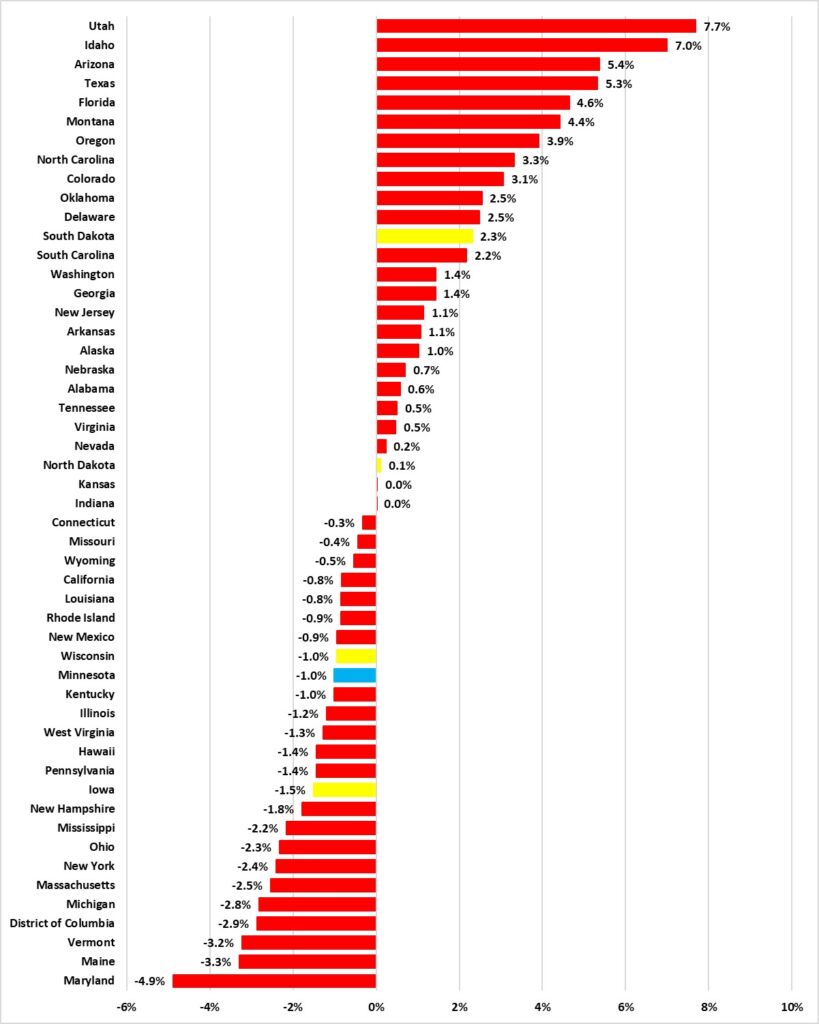Migration won’t solve Minnesota’s labor shortage while policy drives people away
Yesterday, I wrote about the Chamber of Commerce’s new 2023 state of business retention and expansion in Minnesota report which identified “Minnesota’s high state tax rates and lack of available workers as the top two barriers that prevented businesses from expanding in Minnesota.” I noted that:
If our state’s employers are short of workers there are two obvious sources of additional ones in the short to medium term. One is to get more of the people in the state working. The other is to get more people into the state to work.
I looked at how much potential new labor there is in the state yesterday. But, at some point, you have everyone working who is going to be. Minnesota might be closer to that point than most with its relatively high employment ratios and relatively low share of “true” unemployed. Once a state reaches that point it needs to add new workers to the pool. Given that increased birthrates will take at least 16 years to have an effect, in the short to medium term, new workers will have to come from out of the state.
Can Minnesota attract workers?
Sadly, the prospects for Minnesota are not good. As I noted in January, Census Bureau numbers showed that 19,400 Minnesotans fled the state to live elsewhere in the United States in 2021-2022, the highest number in at least three decades. This broke the previous record of 16,312 set just the previous year. Minnesota has been losing residents to other states for years, but the pace of exit has quickened since 2020.
If we are to ease our state’s labor shortage by attracting workers from elsewhere, we will need to reverse this exodus of Minnesotans. To do that, we must start by identifying the reasons they are leaving.
People choose which state to live in for a variety of reasons. As Christopher Ingraham of the Minnesota Reformer noted recently:
Researchers have found that costs of living, job opportunities, recreation, crime and weather and climate have a major influence on where people move.
But, as I noted:
The state government exercises little control over factors such as “recreation,” and even so the 2023 U.S. News & World Report “Best States Rankings” study ranks our state 7th for ‘Natural Environment’ and we still have record numbers of people leaving. It exercises even less control over “weather and climate,” despite Gov. Walz’s bizarre claims to the contrary.
The state government exercises rather more control over the other factors; “cost of living, job opportunities, [and] crime.” But Minnesota scores poorly on these measures. Housing and child care are relatively expensive here, largely because of government actions; our state is one of only 13 not to have recovered its pre-pandemic peak of employment; and Minnesota’s crime rate is now higher than the national average.
The government of a state like Minnesota that has climate, which it can do nothing about, as a “push” factor needs to offset it with “pull” factors in areas that it does have control over.
Tax is one of those areas — see South Dakota, whose climate is much the same as ours but which has seen net inflows of migrants in each of the last seven years, as an example. As I’ve noted before, a recent paper by economists Henrik Kleven, Camille Landais, Mathilde Muñoz, and Stefanie Stantcheva that: “review[s] a growing empirical literature on the effects of personal taxation on the geographic mobility of people and discuss[es] its policy implications” finds that:
There is growing evidence that taxes can affect the geographic location of people both within and across countries. This migration channel creates another efficiency cost of taxation with which policymakers need to contend when setting tax policy.
More specifically:
This body of work has shown that certain segments of the labor market, especially high-income workers and professions with little location-specific human capital, may be quite responsive to taxes in their location decisions.
Minnesota was already one of the highest tax states in America. That, the empirical literature tells us, is one reason for our outflow of residents and the shrinking of our labor force, seen in Figure 1. Indeed, Minnesota is one of 25 jurisdictions which saw its labor force shrink from 2019 to 2022 and its performance was worse than in 34 other states.
Figure 1: Change in the Civilian labor force, 2019 to 2022

In this light, the results of the recent legislative session were, once again, disappointing. By enacting $10 billion of tax hikes over the next four years, the state government has made Minnesota even less attractive to potential residents than it was. It seems as though the DFL’s plan is to offset the additional “push” factor of higher taxes with “pull’ factors such as expanded welfare and extreme social policies. Will it work? Watch this space.